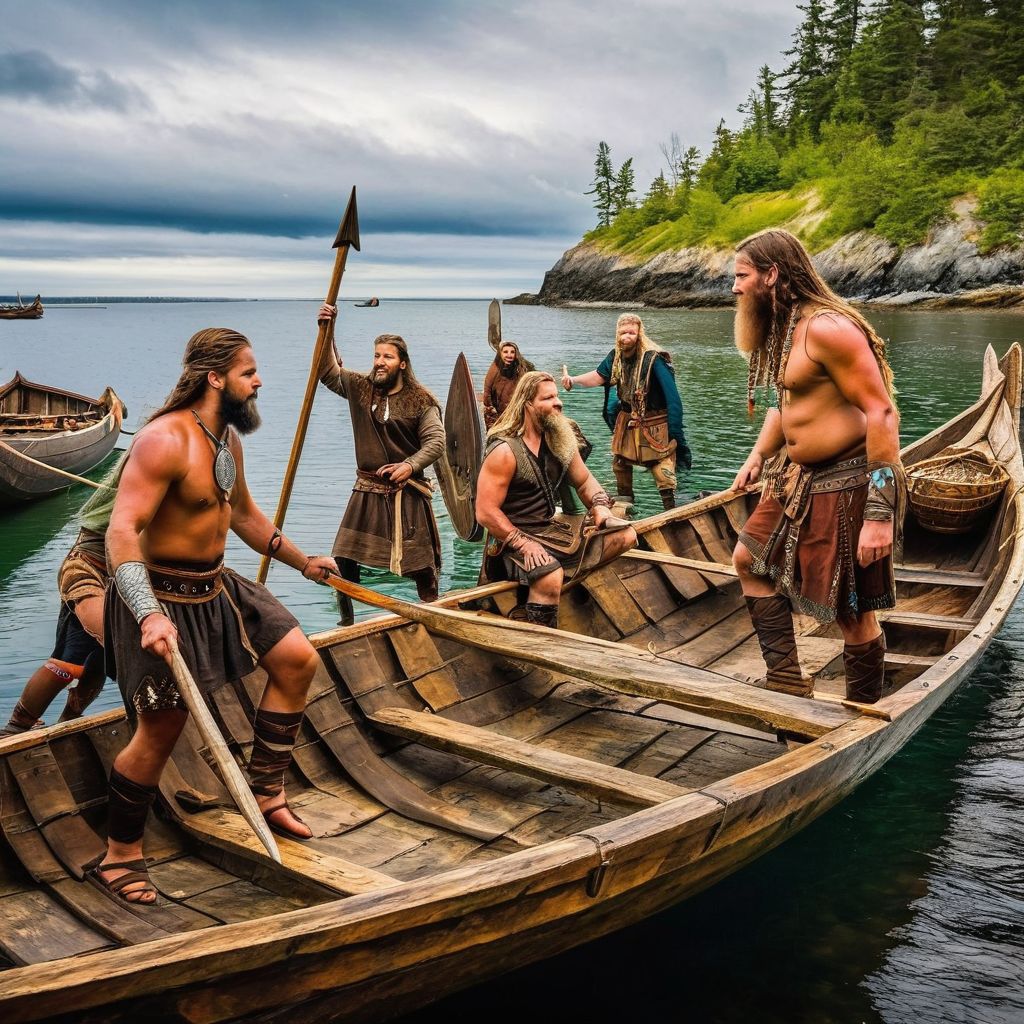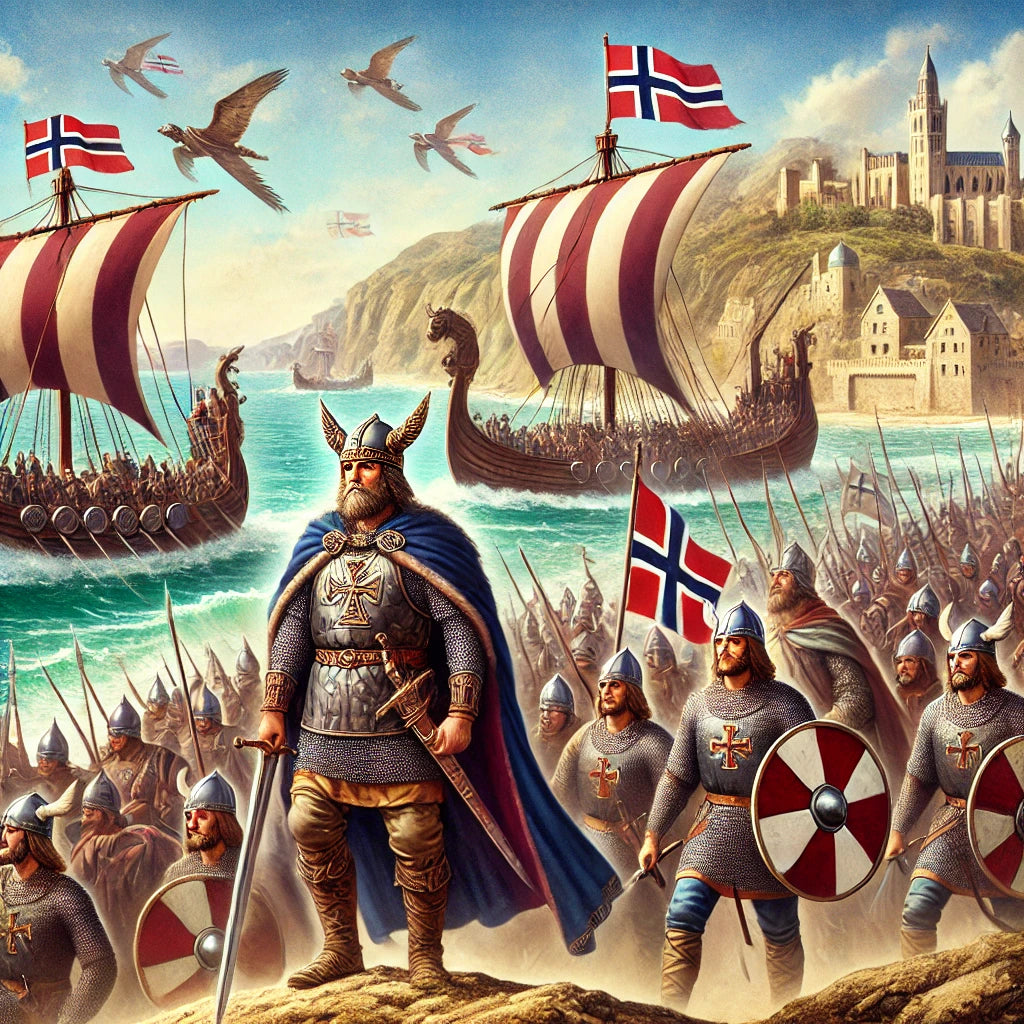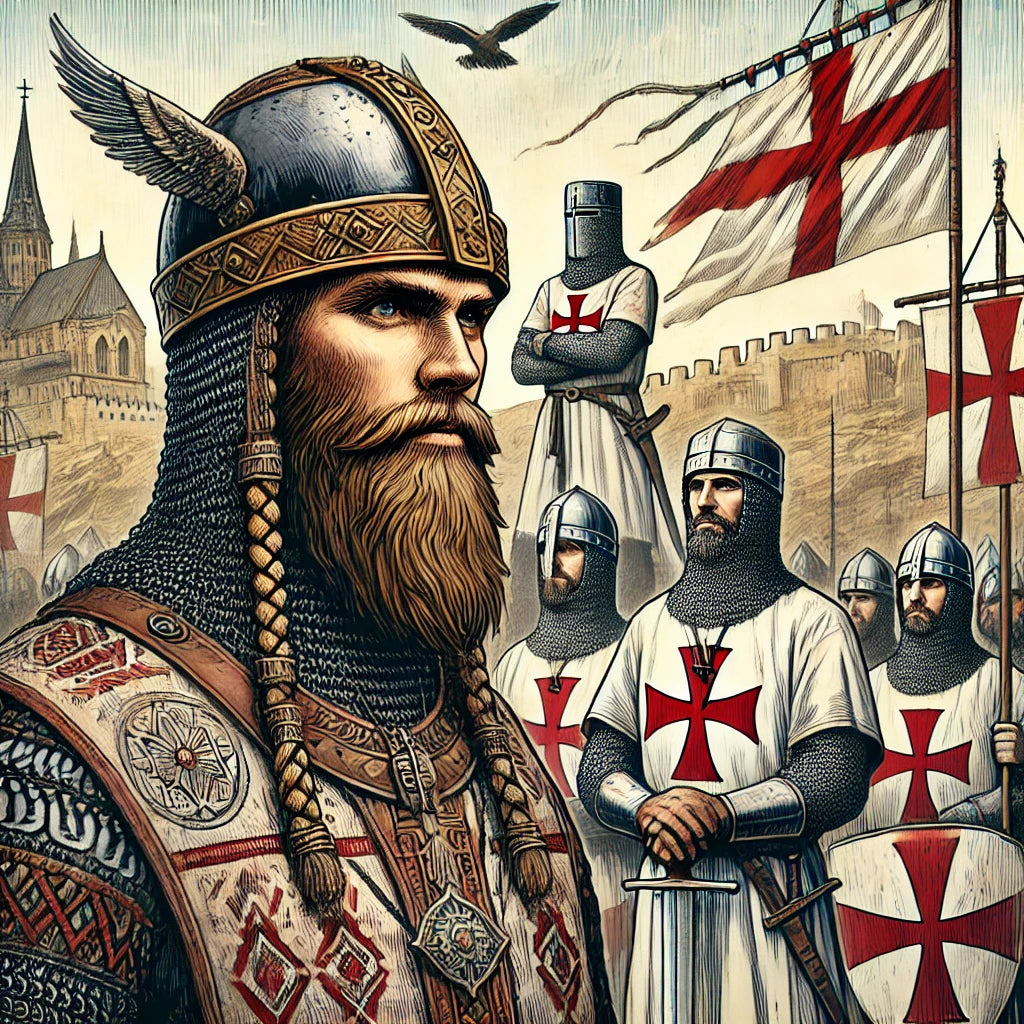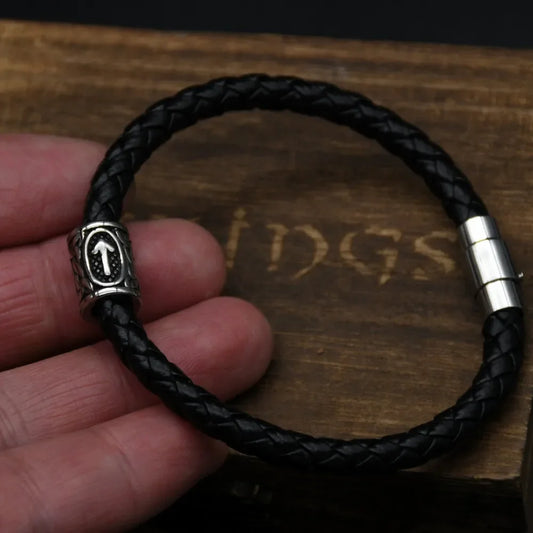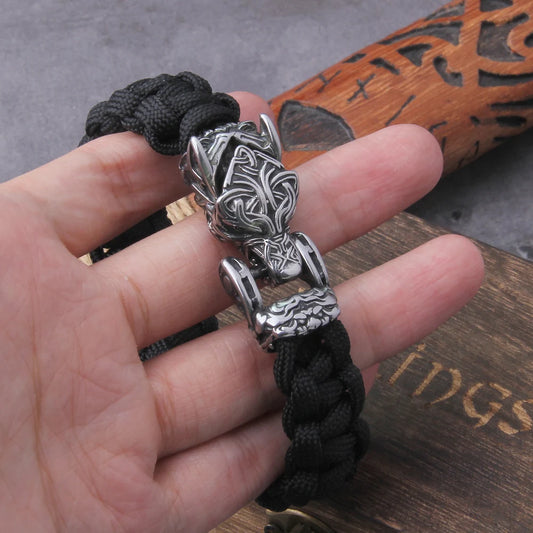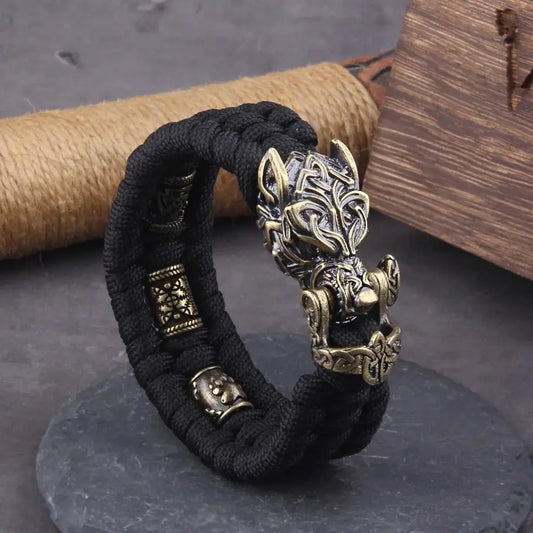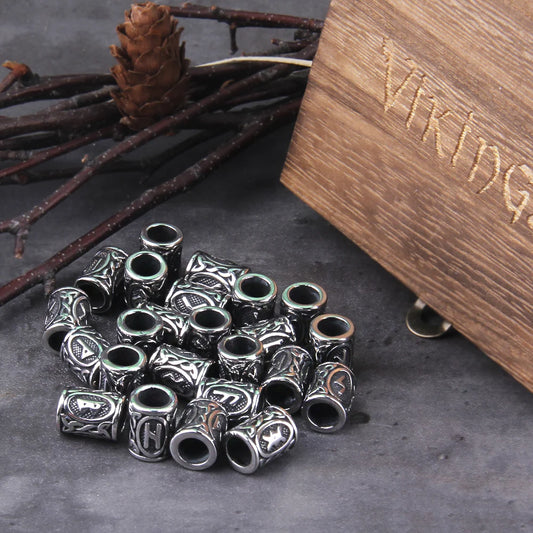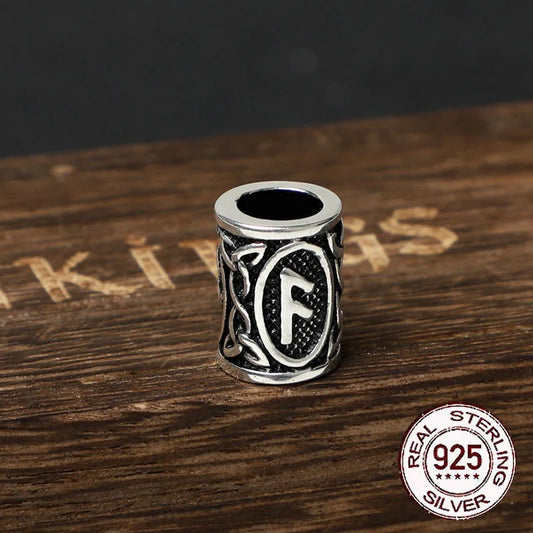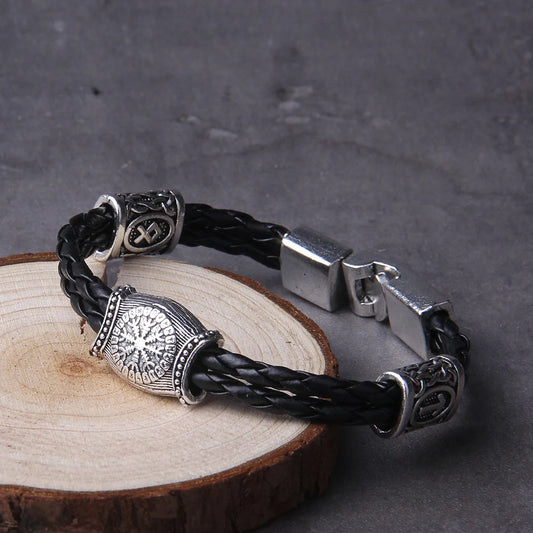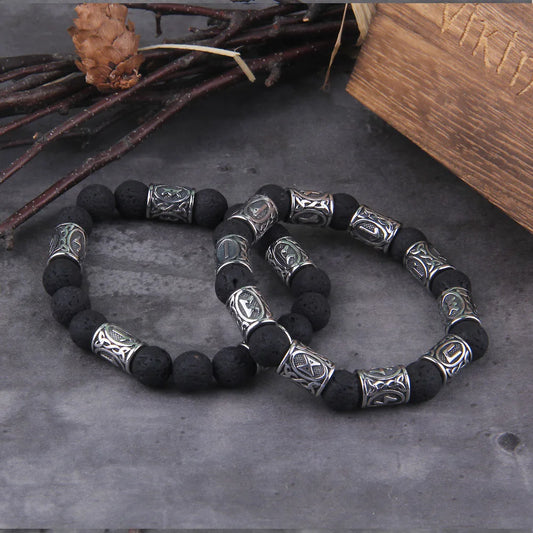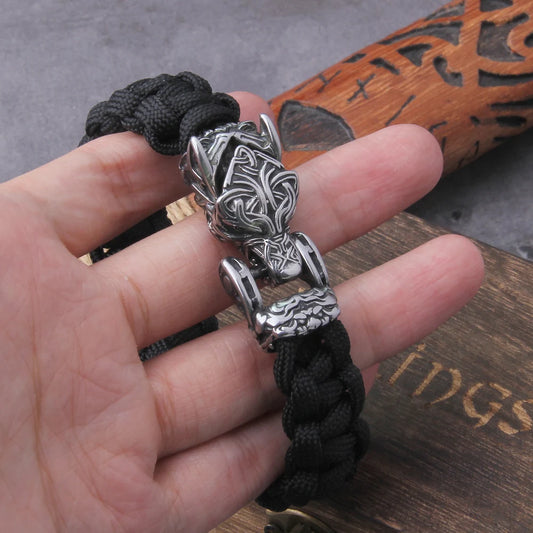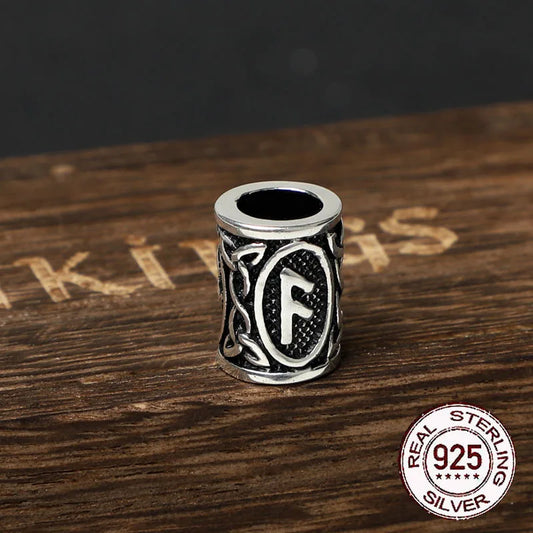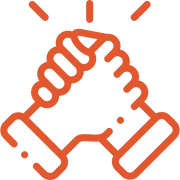The berserker (in Old Norse berserkr, plural berserkir) refers to a stealth warrior who goes into a sacred fury (in Old Norse berserksgangr, "walk, pace of the fierce warrior") making him overpowered and capable of the most inconceivable feats.
Although the character appears especially in the sagas and the Nordic and Germanic mythologies (examples : Arnwulf, Bernhari, Berthramm, Gundhramm, Haimric, Hlodwig, Richari, Theudberga, Warinhari, Wilhem, etc.), it is nevertheless attested in more historical sources, such as the Haraldskvæði (see the account of the battle of Hafrsfjördr) where the berserkers are also called úlfheðnar, or the History of Saint Olaf, in the Heimskringla.
Berserker Etymology
"Berserker" could mean "bearskin" (from Old Norse ber särk: "bearskin shirt"). There is another theory, which interprets the word as "unprotected" (from Norwegian "berr särk", bare chest).
This interpretation, hardly contested in the past, was defeated from the middle of the nineteenth century. It came back into favor between the two world wars, defended by Erik Noreen, then Hans Kühn.
Since then, the controversy remains open, but the majority of modern authors would rather lean, with Otto Höfler, for the first solution.
According to Régis Boyer, the word berserkr can mean that the bear warrior fought uncovered (without a shirt), but more probably that he had the strength of a bear whose skin he wore as armor (bear shirt).
The meaning "uncovered", "unprotected", could also refer not to the clothing but to a fighting attitude, a warrior who was considered brave and did not wear a shield but used his two hands to handle the sword or axe (in the manner of the "sword players" - "double-solde" of the Renaissance).
The term has been adjectivized in English, where "to go berserk" means in colloquial language "to go berserk", "to lose control of oneself".
Legacy of the Viking Berserkers
We can distinguish three classes of warriors of this type:
The Svinfylkingars - boar-warriors,
The Ulfhednars - wolf-warriors,
The Berserkers - bear-warriors.
In mythology, the berserkers in the broadest sense would be warriors of Odin, and the living equivalent of the Einherjar. Berserkers fight in a state of trance provoked by the animal spirit of the warrior.
This fury would be linked to the person's animal totem. Berserkers are not only warriors, they are also priests of the Nordic gods and particularly of Odin.
Berserkers were supposed to form the bodyguard of the Scandinavian kings in troops of 12 warriors.
Some accounts and archaeological evidence mention a clan named "Clan of the sons of Odin" near Skagen (Denmark) whose men's skeletons were about two meters tall.
The warriors of Odin were gathered in brotherhoods and each aspirant had to pass an initiation of which certain details reached us thanks to the saga of Hrólf Kraki: the aspiring berserker had to ritually kill the image of the bear, then to drink its blood so that the power of the beast was spread in him.
He would then become a berserker and obtain in addition to his fury the gift of Hamrammr, that is to say the power of metamorphosis which allowed him to modify the perception that the others have of him, but also to appear under animal form.
During their fits of rage, the berserkers would let their human mind fade away to let the animal mind take control.
All young warriors had to undergo an important ritual with their seer: the ritual of awakening. This ritual was the very meaning of their sacred anger: either they survived or they died.
If they survived the ritual, they had to wear a kind of tattoo in the shape of a wolf as well as a snake biting its tail and the sign of the clan to which they belonged.
Historical Accounts of Viking Berserkers
The first berserk warriors were the Hari people, but historians know too little about berserkers for lack of material evidence, and in particular whether one was born a berserk.
However, as onomastics and sagas reveal the existence of lines of berserkers, one can lean towards the hereditary character of the phenomenon.
We only know that they dressed in bear, wolf or boar skins, and fought under the influence of Óðinn's fury (berserksgangr), which was said to give them near-invincibility in hand-to-hand combat.
Indeed, the Ynglinga Saga says of them: "His [Óðinn's] men went forth unarmored, enraged as dogs or wolves, biting their shields, strong as bears or bulls, and killing people in one blow, but they were not stung by iron or fire.
They were called berserkers. In practice, their furor made them insensitive to injury and fear.
Vincent Samson, in an exhaustive study, shows that the presentation of berserkers has evolved over time. Forming a close guard around kings in the skaldic poems of the early tenth century, they are surrounded by great prestige throughout the continental Scandinavian world.
Defeating a berserk in single combat is a feat worthy of the greatest heroes. They are shown in a much less positive light in the Icelandic sagas of the late Middle Ages.
According to the sagas, the berserksgangr was accompanied by manifestations such as revolting eyes, howling (sometimes associated with those of wild beasts) or the biting of the edge of the shield, results of furor; the berserk warriors were capable of various feats: increased strength, ability to pass through fire, invulnerability to the blows of their opponents.
Tacitus (Germania, III) already mentioned the practice of bardit or barritus where the warriors "sing" behind their shields (which can remind the bite of the berserkers' shield). Similarly, in the Poetic Edda (Hávamál, 156), Óðinn sings under the shield to make his companions invincible.
In the Icelandic sagas, after the arrival of Christianity, the character of the berserker evolves into that of a brute, often seeking to appropriate by force the goods or even the wife of his adversary.
He becomes the "villain", usually defeated by the hero at the end of the story. This is the interpretation of Régis Boyer, for whom the prestige of these warriors at the time of the sagas should be qualified; indeed, in the Icelandic sagas, the berserkers are often depicted as brutes, who are, precisely, easily defeated by the young hero, more cunning.
The Icelandic sagas represent late views of the Norsemen, since they were written after the Christianization of the island.
The Íslendingabók, or "Book of the Icelanders", claiming to retrace the colonization of Iceland, was thus written by a priest two centuries after the facts related.
It is thus necessary to note that the dogma of this religion, new for these people, could have tainted the prestige enjoyed by the berserkers, with the aim of better undermining the bases of the old beliefs.
An attempt to explain it has been sought in the use of drugs, such as fly agaric or black henbane, or in shamanic rites. Other authors wanted to see a physiological affection.
Another interpretation proposed by a non-medievalist historian was that the berserkers were in fact combatants suffering from psychological problems linked to war, notably what is today designated as post-traumatic stress disorder; or at least in such a perspective, the presence of berserkers in the sagas would be linked to the hypothetical existence, in certain Scandinavian warriors, of such psychoses.
According to Claude Lecouteux hamr, "skin", in Norse mythology, is one of the forms that the "soul" can take, as man can have several. It is precisely the internal form that intimately follows the body envelope.
The manifestation of the hamr is accompanied by an increase in strength, can take on the aspect of an animal, and can overcome distances and obstacles. The change of form, "while the individual falls into lethargy", is "a point which exactly recalls the trance during which the spirit of the shaman visits the other world and enters into communication with the spirits he questions".
Régis Boyer, following Peter Buchholz, attributes shamanic connotations to the phenomenon. This thesis is, on the other hand, refuted by François-Xavier Dillmann and Vincent Samson.
In Scandinavian and Icelandic literature, it is the figures of the wolf and the bear that come up most frequently when there is talk of "travel in form".
When it comes to the wolf, it is the vargúlfr, reminiscent of the lycanthrope, but also the vargynjur, the woman-wolf. When it comes to the bear, it is the mannbjörn, the bear-man.
These two forms are also the representatives of Odin's warriors (berserkir). The Berserk thus takes the form of a bear or a wolf in his furor.
Viking Berserkers in Popular Culture
Berserkers in Literature
- In the Ynglingar Saga (1225) by Snorri Sturluson.
- In the Berserker series (1967-1979) by Fred Saberhagen.
- In Legend (1984) by David Gemmell, Regnak (or Rek) is a berserk hero of the book.
- In Robert McCammon's Hour of the Wolf (1989), the berserker is a huge, extremely aggressive and deadly male wolf that the members of the werewolf pack to which the hero belongs must confront.
- In the Mercy Thompson (2006-2017) and Alpha and Omega (2011-2018) sagas by Patricia Briggs, Marok Bran is the Berserker.
- In The Shadows of the Night (2010), volume 9 of The Immortals After Dark series by Kresley Cole, the author tells a story between Aidan the Proud, a Berserker, and Regin the Radiant, a Valkyrie.
- In The Berserker's Redemption (2011) from Karen Marie Moning's Highlanders saga, the author tells the romantic story of Berserker Gavrael McIllioch in High Scotland.
- The title of Michael Grant's novel BZRK (2012), as well as the organization of the same name in it, directly references the word "berserk."
- In Aurélie Wellenstein's The King of the Beasts (2015), the characters change into "berserkir ".
- In Rick Riordan's Magnus Chase and the Gods of Asgard trilogy (2015-2017), the character of Halfman Gunderson resides in Walhalla, having been killed with twenty arrows to the chest while trying to protect his thane.
Berserkers in Movies
- In the movie Nightbreed (1990), the inhabitants of Midian keep the Berserkers, uncontrollable and bloodthirsty creatures, prisoners in underground cells.
- In The Lord of the Rings: The Two Towers (2002), and more precisely during the battle of Helm's Deep, the Berserkers are the first Uruk-hai to be sent into hand-to-hand combat via siege ladders.
- In Viking: The Berserkers (2014), by Anthony Smith.
- In Hercules (2014), Tydeus of Thebes, a friend of Hercules, has Berserk behavior.
- In Transformers: The Last Knight (2017), a Decepticon is named Berserker.
- In Alita: Battle Angel (2019), Alita is a teenage cyborg girl who is a Berserker.
Berserkers in Series
- In the Teen Wolf series, season 4, the Berserkers are depicted wearing animal skulls on their heads and led by a were-jaguar.
- In Marvel: Agents of S.H.I.E.L.D., the agents discover an Asgardian staff, the Staff of the Berserker, which increases strength and anger tenfold. Elite Asgardian soldiers used the staffs in battle.
- In Sleepy Hollow, season 3, they are depicted as supernatural warriors, sent through the box of Pandora.
- In Michael Hirst's Vikings, season 4 episode 4, Bjorn Ironside fights a berserker.
- In Grimm, season 3, Berserker is one of the many names of a Wesen wolf, called "Wildesheer".
- In the series The Innocents, season 1 (episode 5), berserkers are considered to be affected by the same evil as June allowing her to change appearance during her attacks.
- In the animated series Archer, Sterling Archer's butler, Woodhouse, tells of going into a berserker rage over the death of his lover during World War II and avenging him during this episode.
Berserkers in Comics and Anime
- In Sláine (1983) by Pat Mills and Simon Bisley, Sláine turns into a berserk during one of the attacks.
- In Berserk (1989) by Kentaro Miura.
- In Le Bal Des Vampires (2003), fourth volume of the comic book series Requiem, Chevalier Vampire by Mills Ledroit and Olivier Ledroit.
- In Neon Genesis Evangelion, the Berserker mode is attributed to the Evas who enter a phase of murderous madness and become uncontrollable by the pilots.
- In Dragon Ball Z, the Saiyans, warriors from another planet, have the ability to transform into giant monkeys on the nights of the full moon, which evokes the animal totem of the berserk.
- In Dragon Ball Super, the character of Kale, a Saiyan, transforms into a Super Saiyan called "Berseker". The same goes for Broly in the movie named after him.
- In Naruto, the character of Jûgo, by absorbing natural energy, transforms into a creature similar to a berserk.
- In Fate/stay night by Datto Nishiwaki, the Berseker is the servant of Ilyasviel von Einzbern. In Fate/zero, he is the servant of Matou Kariya. In the license in general, it is a Servant class known for its extreme strength but also for its aggressiveness making it difficult to control.
- In Yukito Kishiro's Gunnm, it is the second body of Gally.
- In Ken-ichi the ultimate disciple, Berserker is the second body of the organization "Ragnarok".
- In Berserkers, the fourth volume of the series Worlds of Thorgal - Thorgal's Youth. Following the kidnapping of Aaricia by the berserkers, a Viking expedition, including Thorgal, Sigurd and Ratatosk, sets sail to find her.
- In Vinland Saga, the character of Björn eats mushrooms several times, which makes him enter a berserker mode.
- In Blood Lad, it is said that Full Metal Evil Jack is a Berserker.
- In Attack of the Titans, the Titan Assailant goes into berserker mode to fight the female Titan.
- In "Demon Slayer", Inosuke Hashibira's character is a berserker with his animal appearance and his "beast's breath"
Berserkers in Music
- The Berzerker, an Australian band, whose particularity is to wear particularly scary masks both in their videos and on stage.
- Apoptygma Berzerk, a Norwegian band.
- The Dutch record label BZRK Records.
- The fans of the band Black Label Society are called the Berserkers. The band actually released a song called Berserkers in the album 1919 Eternal.
- Berserker (1984), a song performed by Gary Numan.
- Rabiosa (2011), a song by Shakira, is the Spanish translation of the word "berserker", used here in the sense of "going nuts", but also for the metaphor with the wild warrior.
- Berzerk (2013), a song by Eminem. The term "Go berserk" is a phrase that comes up often in the song, meaning "going berserk".
- The Sons Of Odin, a song by the band Manowar, is about Berzerken.
- Berzerk, a song of the band Krush released on the split 7 album with the Japanese band Unholy Grave.
- Berserker, an album of the band Amon Amarth, including the track The Berserker at Stamford Bridge which tells the story of a Danish berserker at the Battle of Stamford Bridge.
- Berserker, an album by the band Beast in Black.
- Berserker (2020), a riddim track by the artist Samplifire.
Berserkers in Video Games
- Berserk, a rogue-like video game on the Vectrex console.
- In Fire Emblem, the Berserker is a character class wielding a gigantic axe and having a high strength and critical hit probability.
- In Empires: Dawn of a New World, the Berserk is a French infantry unit from the Middle Ages to the age of gunpowder.
- In Rome: Total War, Germanic units are berserk troops. They are few in number, but they wreak havoc once they are intoxicated by the intoxication of battle.
- In Baldur's Gate, the Ranger Minsc can use a special ability called "Berserk", which consists in putting him in a state of fury to improve his abilities and the damage he inflicts, but under the effect of berserk rage, he can also attack his allies.
- In the Elder Scrolls series, Orcs have an innate Berserk power that, when activated, increases the character's strength, health and fatigue at the expense of agility. On the island of Solstheim, one can also meet "Tuneless" (or Berserkers), hostile islanders driven mad by the cold and the abuse of mead.
- In Dofus, the Berserkers character class is called Sacrier.
- In Ragnarök Online, the Lord Knight has an ability called "Berserk" which allows him to attack at full speed and with insane strength; the character's health points drop as he goes along and he is unable to do anything but attack.
- In Kingdom Hearts, the character of Saïx can enter in fury, thus in Berserk mode. He controls similars called Berserker.
- In Final Fantasy X-2, the Berserk class gives the character the appearance of a warrior covered with an animal skin and patterns drawn on the body; it has different abilities such as Fury, which makes the character uncontrollable until his death.
- In Final Fantasy XI, the Warrior class has a Berserk skill that greatly increases their attack and decreases their defense.
- In Guild Wars, the skill of the Warrior class is called "Berserk Pose" and allows to attack faster.
- In Guild Wars 2, warriors can unlock the ultimate Berserker class to increase their power tenfold.
- In Age of Empires II: The Age of Kings, the Berserk Warrior (in the game, "War Bishop") is an infantry unit unique to the Viking people that can regenerate.
- In Fate/stay night, later adapted into manga and anime, one of the servants is part of the Berserker class.
- In Warcraft III The Frozen Throne, the headhunter troll evolves into a "berseker troll", which can increase its damage output, but doubles its damage output.
- In World of Warcraft, the warrior class' stance is called Berseker Stance. It allows normal melee attacks and damage dealt to generate rage.
- In Paraworld, the berserker is a special unit that can be produced with the help of Anthony Cole. In the presence of an enemy, the berserker becomes uncontrollable.
- In Diablo II, the Barbarian class has an attack called "Berseker" that allows it to inflict enormous damage, while losing all of its defense.
- In Lineage II, the Berserker is a class of the Kamael race that deals enormous damage at the expense of defense and evasion.
- In Priston Tale, the skill of the Fighters class is called "Berserker" and increases the attack power considerably.
- In Dark Age of Camelot, the Berserker is a class of the kingdom of Midgard.
- In Metin, the Berserk is a skill that increases attack speed and movement speed.
- In Fable, the character can possess the "Berserk" attack, by which he is struck with a killing spree.
- In Nostale, the "berserker" is the fourth fencer specialization to be obtained.
- In Gears of War as well as in Gears of War 2, there are (female) enemies called "Berserker" who are invincible unless they use unconventional weapons.
- In Runescape, the "berserker" helmet is a helmet with horns. There is also a "Berserker" rank in the Dungeoneering skill, which characterizes a player who has demonstrated great skill in combat.
- In Age of Conan: Hyborian Adventures, the Barbarian Marauder has a Berserk skill tree, limiting his armor to leather armor and allowing for quick, powerful and bloody attacks.
- In Dragon Age: Origins, a warrior class character specialization is called Berserker.
- In Unreal Tournament 2004, the player can activate a Berserk mode with a keystroke combination, which allows him to shoot twice as fast.
- In Grand Fantasia, the berserker is a class that has a fairly good defense and can inflict incredible damage.
- In League of Legends, Olaf, one of the playable characters designated as a berserker, sees his killing ability increase as he nears death.
- In Urban Rivals, the Berzerks are a clan that went into a huge rage after inhaling "Xantiax" gas.
- In the Final Fantasy game series, the job "Berzerk" comes up a lot. He is referred to as a bloodthirsty character who gets his power from the blows he takes.
- In Chrono Trigger, an accessory called "Ring of Berserk" makes the character uncontrollable in battle, while increasing his attack and defense characteristics.
- In Heroes of Might and Magic V: Hammers of Fate and Heroes of Might and Magic V: Tribes of the East, the berserker is an upgraded unit of the dwarf faction, relying on attack power and speed, at the expense of defense.
- In Hitman: Absolution, the player earns the title "Berserker" by killing five people with an axe.
- In Slaves to Armok II: Dwarf Fortress, Dwarves can become Berserkers with increased strength and a killing spree.
- In The Elder Scrolls V: Skyrim, the player can allocate his skill points to become one of the warrior-falcons andcan, by joining the Companions of Blancherive, become a werewolf.
- In Dota 2, Huskar, one of the playable characters, has as his 3rd power the Berserker's Blood, which adds attack speed for the percentage of health he lacks.
- In The Battle for Wesnoth, one of the dwarf units is called a "berserker" and fights to the death or his opponent's death.
- In War of the Vikings, the Berserker is a character class.
- In Hearthstone, Bersekers (Berseker Amani, Berseker Gurubashi, Berseker Skimmer) are creatures that increase their attack strength when wounded.
- In Game of Thrones: A Telltale Games Series, in the North Grove, the warriors have a berserk behavior to avoid emotions during battles against the undead.
- In Invizimals, the berserker is a stone bear that is possessed by the 1st boss, Hakira.
- In For Honor, there is a Berserker class.
- In Call of Duty: Black Ops III, Berserk is a DLC map.
- In Odin Sphere, one of the playable characters, Oswald, has the ability to transform into a Berserker, after filling his rage bar by hitting his enemies.
- In Diablo III, "Berserker's Rage" is a skill of the Barbarian character class. Its power increases dramatically and its appearance changes.
- In the Mass Effect trilogy, the Berserkers are a group of ultra-violent mercenaries (often Vortchas or Krogan).
- In Goodgame Empire, the Berserker is a very powerful attack unit, reserved for the top 100 most glorious players.
- In Devil Survivor 2, Wakui Keita's character has the power to summon a Berserker to defend against the Septentrions.
- In Civilization VI, Berserker is a special unit of Norway.
- In Middle-earth: Shadow of War, Berserkers are one of the advanced Uruk classes, one of the most effective.

